General Information
This section provides general information about drinking alcohol in Australia. It includes common definitions related to alcohol and alcohol consumption, how consumption is measured, and guidelines for staying safe when drinking.
The primary source of information in this section is the Australian guidelines to reduce health risks from drinking alcohol. (National Health and Medical Research Council, 2019). This is the best source of synthesised national and international evidence currently available concerning the risks associated with alcohol consumption. The purpose of the guidelines is to allow individuals to make informed decisions regarding the amount of alcohol that they choose to drink.
What is a standard drink?
A standard drink is a unit of measurement. In Australia, a standard drink refers to any drink that contains 10 grams (or 12.5 millilitres) of pure alcohol. A standard drink contains the same amount of alcohol regardless of alcohol type (e.g. beer, wine, or spirits), or whether it is mixed with soft drink, fruit juice, water or ice.
Further information about standard drinks is available from the Australian Government Department of Health.

Source: National Health and Medical Research Council (NHMRC) (2019). Australian guidelines to reduce health risks from drinking alcohol.
Source: National Health and Medical Research Council (NHMRC) (2019). Australian guidelines to reduce health risks from drinking alcohol.
Standard Drink: A drink that contains 10 grams (or 12.5 millilitres) of pure alcohol.
What is the difference between a standard drink and a serving of alcohol?
A standard drink may not be the same as a serving of alcohol. A standard drink contains 10 grams of pure alcohol (see FAQ: What is a standard drink?). However, because there are no common glass sizes used in Australia, a serving of alcohol may contain more than one standard drink.
Further information about standard drinks is available from the Australian Government Department of Health.
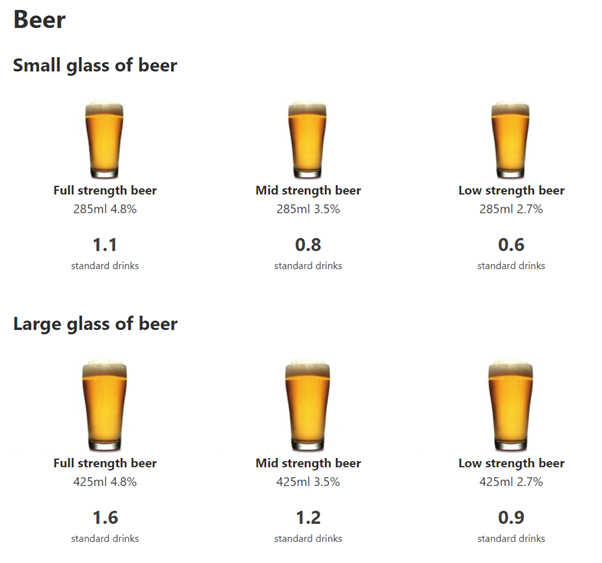
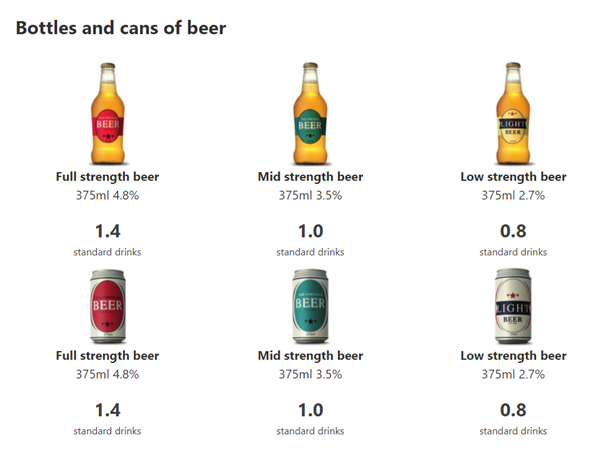
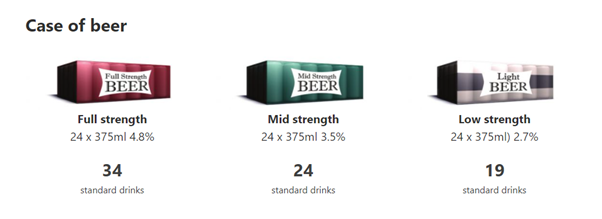
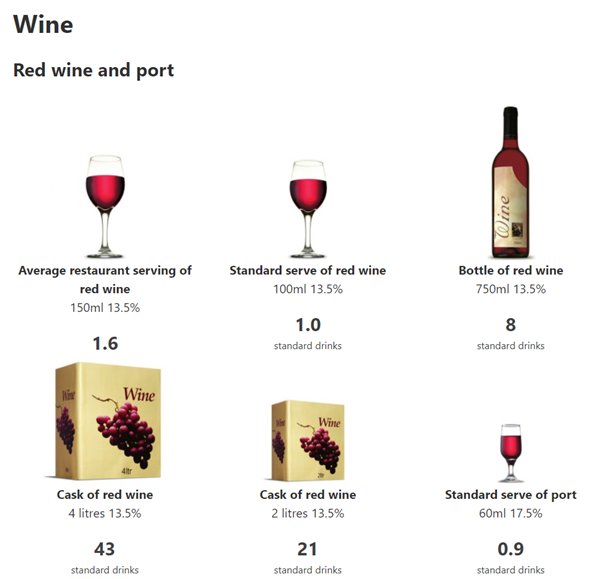
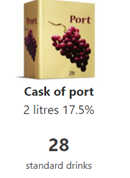
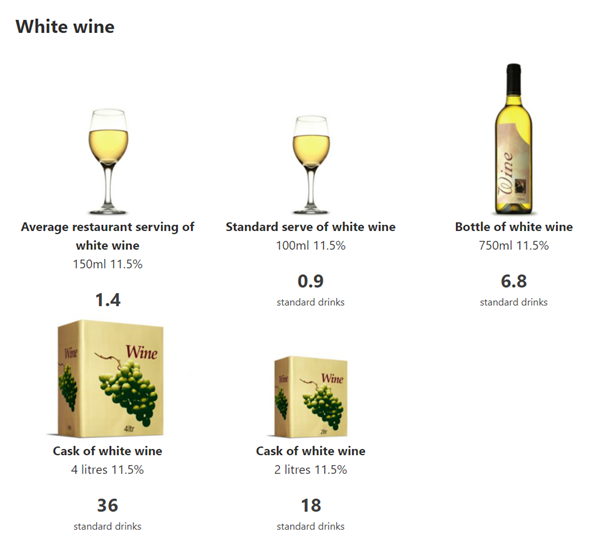
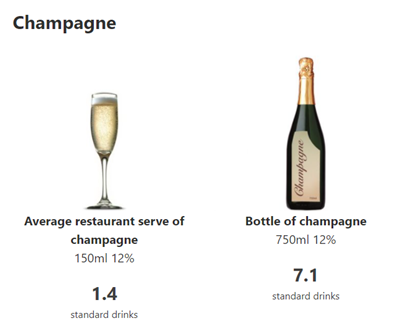
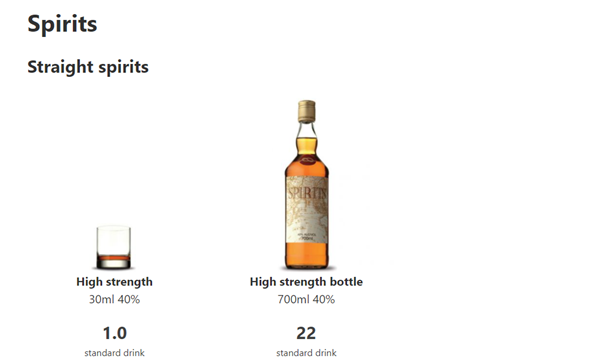
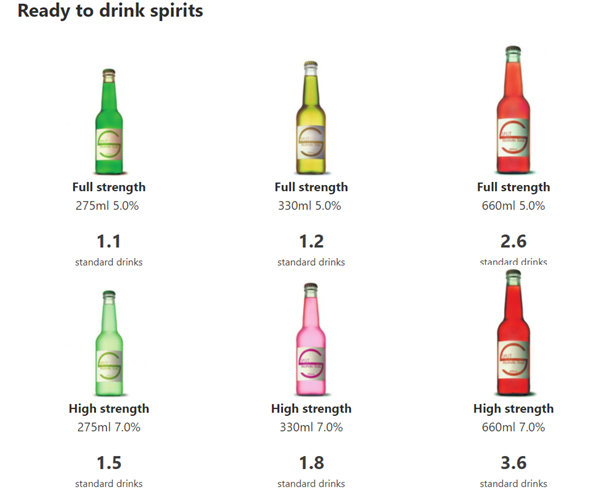
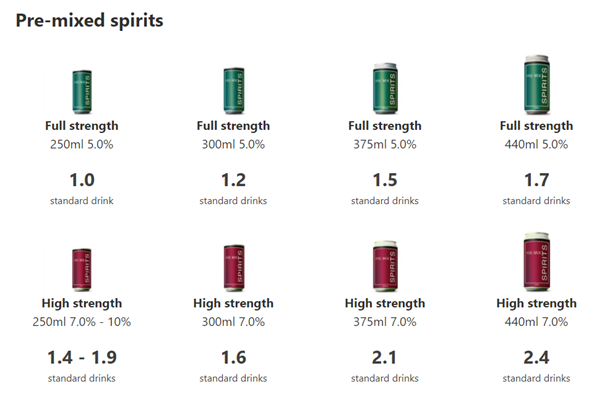
Source: Australian Government Department of Health (2020). Standard drinks guide.
Source: National Health and Medical Research Council (NHMRC) (2019). Australian guidelines to reduce health risks from drinking alcohol.
Standard Drink: A drink that contains 10 grams (or 12.5 millilitres) of pure alcohol.
What is a drinking occasion?
A drinking occasion is any time a person consumes one or more drinks containing alcohol and during this period of time their blood alcohol concentration (BAC) does not return to zero.
A drinking occasion might include drinking at home followed by drinking at other venues. For example, someone may drink two beers at home, then a glass of wine at a restaurant, followed by a shot of spirits at a pub. If this person's BAC did not reach zero at any time between these drinks, this constitutes a single occasion of drinking.
Source: National Health and Medical Research Council (NHMRC) (2019). Australian guidelines to reduce health risks from drinking alcohol.
Blood Alcohol Concentration (BAC): A commonly used measure of alcohol intoxication, referring to the amount of alcohol present in the bloodstream. For example, a BAC of 0.05% means that there are 0.05 grams of alcohol in every 100 millilitres of blood.
Drinking Occasion: A period of time during which a person consumes one or more drinks containing alcohol and their blood alcohol concentration (BAC) does not return to zero.
What is binge drinking?
“Binge drinking”, is commonly understood to mean intentionally drinking enough alcohol to get drunk. It involves drinking heavily on one occasion or over several days or weeks. However, binge drinking is not scientifically defined, and there is no single accepted definition.
A commonly used proxy measure of binge drinking is the consumption of five or more standard drinks on one drinking occasion.
Source: National Health and Medical Research Council (NHMRC) (2019). Australian guidelines to reduce health risks from drinking alcohol.
Drinking Occasion: A period of time during which a person consumes one or more drinks containing alcohol and their blood alcohol concentration (BAC) does not return to zero.
Standard Drink: A drink that contains 10 grams (or 12.5 millilitres) of alcohol.
Is there a safe level of drinking?
There is no level of alcohol consumption that is guaranteed to be completely “safe” or “without risk”. Current Australian alcohol guidelines describe a level of drinking that enables healthy adults to reduce the risk of harm from alcohol-related disease or injury.
These guidelines recommend consuming no more than 10 standard drinks a week and not more than 4 standard drinks on any one day. These levels apply to both men and women. For pregnant and breastfeeding women, children, and young people aged under 18, not drinking at all is recommended as the safest option.
For more information on current Australian alcohol guidelines see FAQ: What are Australia’s alcohol consumption guidelines? A copy of the complete guidelines is available from the National Health and Medical Research Council (NHMRC).
Source: National Health and Medical Research Council (NHMRC) (2019). Australian guidelines to reduce health risks from drinking alcohol.
Standard Drink: A drink that contains 10 grams (or 12.5 millilitres) of alcohol.
What are Australia’s alcohol consumption guidelines?
Australia’s guidelines in relation to alcohol are developed by an expert committee of the National Health and Medical Research Council (NHMRC). The most recent guidelines were released in 2019. There are three guidelines for reducing the health risks associated with drinking alcohol:
Adults: To reduce the risk of harm from alcohol-related disease or injury, healthy men and women should drink no more than 10 standard drinks a week and no more than 4 standard drinks on any one day. The less you drink, the lower your risk of harm from alcohol.
Following this guideline keeps an adult’s risk of harm from alcohol low, but it does not remove all risk. A healthy adult who follows this guideline has a less than 1 in 100 chance of dying from an alcohol-related condition.
Children and young people under 18 years of age: To reduce the risk of injury and other harms to health, children and people under 18 years of age should not drink alcohol.
People under the age of 18 are more likely to suffer harm from alcohol and thus it is recommended that they do not drink alcohol.
Women who are pregnant or breastfeeding: To prevent harm from alcohol to their unborn child, women who are pregnant or planning a pregnancy should not drink alcohol. For women who are breastfeeding, not drinking alcohol is safest for their baby.
Drinking alcohol while pregnant or breastfeeding can harm the developing foetus/breastfed baby. For women who are pregnant, planning a pregnancy, or breastfeeding, not drinking is the safest option.
A copy of the complete guidelines is available from the National Health and Medical Research Council (NHMRC).
Source: National Health and Medical Research Council (NHMRC) (2019). Australian guidelines to reduce health risks from drinking alcohol.
Standard Drink: A drink that contains 10 grams (or 12.5 millilitres) of alcohol.
What health issues and situations should be considered when drinking alcohol?
People should consider potential risks from drinking alcohol if they are:
- supervising children or responsible for the safety of others
- engaging in risky activities such as driving, operating machinery, or taking part in water and snow sports
- taking medication or illicit drugs
- young adults aged 18–25 years
- aged over 60 years.
People who have physical or mental health problems should seek advice from a health professional before drinking alcohol. People who drink alcohol should also consider any legal issues which may arise from their alcohol consumption (e.g., drink driving, being intoxicated in public, and purchasing or drinking alcohol under the age of 18).
Further information is available from the National Health and Medical Research Council (NHMRC).
Source: National Health and Medical Research Council (NHMRC) (2019). Australian guidelines to reduce health risks from drinking alcohol.
How much can someone drink and stay below a 0.05% Blood Alcohol Concentration (BAC) level?
A blood alcohol concentration (BAC) level of 0.05% means that there are 0.05 grams of alcohol in every 100ml of blood. There is no level of drinking which guarantees that a person’s BAC will stay below 0.05%. Age, body size, gender, and a range of other factors can affect the rate at which alcohol is absorbed and metabolised when you drink. Everyone is different, and two people can drink the same amount of alcohol but have different levels of alcohol in their bloodstream. However, drinking less than one standard drink per hour should keep most people’s BAC below 0.05%, as the average rate at which alcohol is metabolised is one standard drink per hour.
Source: National Health and Medical Research Council (NHMRC) (2019). Australian guidelines to reduce health risks from drinking alcohol.
Blood Alcohol Concentration (BAC): A commonly used measure of alcohol intoxication, referring to the amount of alcohol present in the bloodstream. For example, a BAC of 0.05% means that there are 0.05 grams of alcohol in every 100 millilitres of blood.
Standard Drink: A drink that contains 10 grams (or 12.5 millilitres) of alcohol.
Are there any health benefits from drinking alcohol?
Recent scientific evidence suggests that any purported health benefits from drinking alcohol have probably been over-estimated. There is some evidence that alcohol has a protective effect for coronary health disease. However, there are safer ways to reduce a person’s risk of coronary heart disease (maintaining a healthy weight, not smoking, reducing blood pressure) and the use of alcohol can still increase their risk of developing other health conditions (cancer, stroke).
Current Australian alcohol guidelines do not recommend drinking for health benefits (see FAQ: What are Australia's alcohol consumption guidelines?).
Source: National Health and Medical Research Council (NHMRC) (2019). Australian guidelines to reduce health risks from drinking alcohol.
Standard Drink: A drink that contains 10 grams (or 12.5 millilitres) of alcohol.
Where can I get help or more information about alcohol?
If you are worried about your own or somebody else’s alcohol use, contact the Alcohol and Drug Information Service (ADIS). The Alcohol and Drug Information Centres are state and territory-based services that offer information, advice, referral, intake, assessment and support. They offer services for individuals, their family and friends, general practitioners, other health professionals, and business and community groups.
To contact ADIS, ring the 24 hour hotline on 1800 250 015 and you will be automatically directed to the ADIS in the state or territory you are calling from.
Source: Australian Government. Alcohol and Drug Information Service website.
